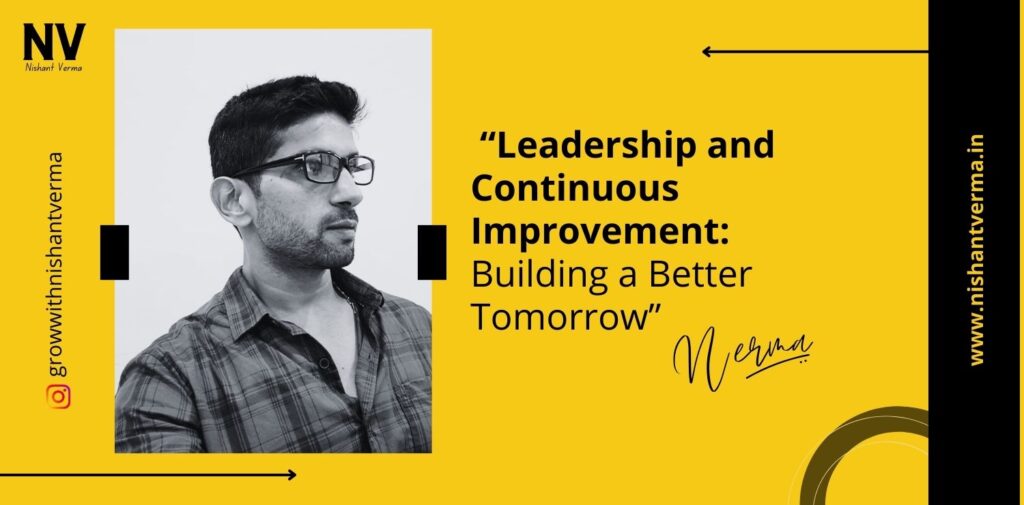Leadership is not just about steering the ship; it’s about constantly striving for improvement. In this article, we’ll explore the crucial connection between leadership and cultivating a culture of leadership and continuous improvement. We’ll break down what continuous improvement means, why it’s essential, and how leaders can foster an environment where every team member is inspired to contribute to building a better tomorrow.

Understanding leadership and continuous improvement:
What is Continuous Improvement?
Continuous improvement is like polishing the ship regularly, ensuring it stays in top condition. It’s an ongoing process where teams consistently seek ways to enhance their performance, processes, and outcomes. It’s like having a crew that always looks for ways to sail more efficiently.
The Role of Leadership:
Leaders are like the architects of improvement blueprints. They guide their teams, encouraging a mindset that embraces change and innovation. If leaders focus on leadership and continuous improvement effectively, they become the captains who lead their crews towards excellence, always raising the bar for success.
Elements of Cultivating a Culture of Continuous Improvement:
Embrace a Growth Mindset:
Embracing a growth mindset is like believing the ship can always set sail to new horizons. Leaders foster a culture where team members see challenges as opportunities to learn and improve. It’s like having a crew that believes they can always become better sailors with practice and perseverance.
Encourage Innovation:
Encouraging innovation is like adding new features to the ship for a smoother journey. Leaders inspire creativity and the exploration of new ideas, ensuring that teams are always searching for better, more efficient ways to navigate challenges. It’s like having a crew that constantly looks for innovative solutions to sail through uncharted waters.
Promote Open Communication:
Promoting open communication is like ensuring everyone on the ship can voice their opinions. Leaders create an environment where team members feel comfortable sharing insights and suggestions for leadership and continuous improvement. It’s like having a crew that collaborates openly to discuss navigation strategies.
Recognize and Celebrate Progress:
Recognizing and celebrating progress is like acknowledging every successful voyage. Leaders appreciate the efforts of their teams and celebrate achievements, reinforcing a positive culture of improvement. It’s like having a captain who cheers for the crew’s success after every challenging journey.
Provide Resources for Learning:
Providing resources for learning is like offering navigation tools to the crew. Leaders ensure that their teams have access to training, knowledge, and tools needed for continuous skill development. It’s like having a captain who ensures the crew has updated maps and charts for their voyages.

Why Continuous Improvement Matters:
Enhances Efficiency and Productivity:
leadership and continuous improvement enhances efficiency and productivity. When teams consistently seek better ways to work, processes become more streamlined, and productivity increases. It’s like a captain who adjusts the sails to catch the wind efficiently, making the ship move smoothly.
Drives Innovation and Adaptability:
Continuous improvement drives innovation and adaptability. When teams are encouraged to explore new ideas, it fosters a culture of innovation that helps organizations adapt to changing environments. It’s like a captain who embraces innovative navigation methods to adapt to different sea conditions.
Builds a Positive Organizational Culture:
leadership and continuous improvement builds a positive organizational culture. When leaders recognize and celebrate progress, it creates an atmosphere where team members feel valued and motivated to contribute to the organization’s success. It’s like a captain who creates a positive and encouraging environment on the ship.
Fosters Employee Engagement:
Continuous improvement fosters employee engagement. When team members see that their contributions lead to positive changes, they become more engaged and committed to their work. It’s like a captain who ensures every crew member plays a vital role in steering the ship.

Implementing Strategies for leadership and continuous improvement:
Encourage a Growth Mindset:
Encouraging a growth mindset is like providing a compass for the crew. Leaders inspire a mindset where challenges are seen as opportunities for growth and improvement. It’s like a captain who motivates the crew to believe in their potential to become better sailors.
Create an Innovation-Friendly Environment:
Creating an innovation-friendly environment is like ensuring the ship’s deck is open for exploration. Leaders promote a culture where team members feel encouraged to suggest and implement innovative ideas. It’s like a captain who welcomes suggestions for improving navigation methods.
Foster Open Communication Channels:
Fostering open communication channels is like ensuring the ship’s radio is always on. Leaders establish a communication culture where team members can freely share ideas and feedback, creating a transparent and collaborative environment. It’s like a captain who listens to the crew’s insights about the journey.
Recognize and Celebrate Achievements:
Recognizing and celebrating achievements is like hoisting the sails after reaching a milestone. Leaders acknowledge and appreciate the efforts of their teams, reinforcing a positive culture of leadership and continuous improvement. It’s like a captain who applauds the crew for successfully navigating challenging waters.
Invest in Learning and Development:
Investing in learning and development is like providing navigation training for the crew. Leaders ensure that their teams have access to resources, training, and opportunities for skill development. It’s like a captain who equips the crew with the knowledge and tools needed for successful voyages.
Case Studies: Real-Life Examples of Continuous Improvement:
Toyota’s Lean Manufacturing Principles:
Toyota’s continuous improvement journey through lean manufacturing principles is a notable example. The company encourages employees at all levels to identify and address inefficiencies in processes, leading to a culture of continuous improvement that has become known as the Toyota Production System.
3M’s Innovation Culture:
3M’s commitment to continuous improvement is evident in its innovation culture. The company encourages employees to spend a significant portion of their work hours on personal projects, fostering a culture of creativity and exploration. This approach has led to numerous breakthrough inventions and product developments.
Challenges and Solutions in Implementing leadership and continuous improvement:
Overcoming Resistance to Change:
Leaders address resistance to change by communicating the benefits of continuous improvement, involving employees in the decision-making process, and creating a culture that values learning and growth. It’s like convincing the crew that adjusting the sails is necessary for a smoother journey.
Balancing Short-Term and Long-Term Goals:
Leaders balance short-term and long-term goals by prioritizing improvements that align with the organization’s overarching vision. It’s like a captain who plans each voyage with both immediate challenges and long-term destinations in mind.
Conclusion:
In the vast sea of leadership, leadership and continuous improvement is the wind that propels the ship towards excellence. Fostering an environment where a growth mindset, innovation, and open communication are valued is not just a task; it’s the essence of creating a workplace where every team member is empowered to contribute to building a better tomorrow. By understanding the elements of cultivating a culture of continuous improvement, recognizing its significance, and implementing strategies effectively, leaders become the captains of a ship that sails confidently towards new horizons with a crew that is inspired, motivated, and always ready for the journey ahead. In essence, leadership and continuous improvement is not just a process; it’s the sail that catches the wind, propelling the ship towards a future of success and achievement in the dynamic world of leadership.




